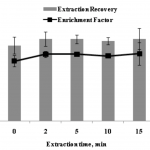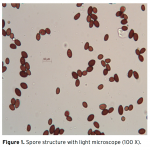| Title | Pages |
|---|---|
| Floristic List of İnönü University (Malatya) Main Campus Area In this research, floristic list of vascular plant specimens which are located in the main campus area of İnönü University have been compiled with stored specimen in INU herbarium and collected specimens in the field. Collection date of the specimen in the list was dated from 1986 to 2015. After the identification of the speci- mens, the total flora has been determined as 552 taxa belonging to 534 species, 320 genera and 85 families. These results are indicated that the flora of main campus area of İnönü Üniversity is the richest biodiversity when it’s compared within the other campus floras in Turkey. The endemism rate of the area is 8.33% for the 46 taxa. The largest 3 families are Fabaceae (57 species), Asteraceae (46 species) and Poaceae (47 species). The largest genera are Medicago (10 species), Euphorbia (9 species), Alyssum, Astragalus and Salvia (7 species). The phytogeographical spectrum of the species is as follows: Irano-Turanian elements 134 (24.27%), Mediter- ranean elements 29 (5.25%) and Euro-Siberian elements 9 (1.63%). 
|
73 - 89 |
| Anticancer Properties of Different Species of Salvia Historically, thousands of different species of plant have been reported as being useful for the treatment of cancer. Salvia species think among these plants. Salvia; “sage” are derived from the Latin salvere referring to remedy properties arrogate to the various Salvia species. Salvia is the largest genus of plants in the mint family, Lamiaceae. In this review we performed to report the anticancer features of different species of salvia
|
91 - 97 |
| Enrichment of Ochratoxin A in Cereals Using Ionic Liquid Based Dispersive Liquid-Liquid Microextraction Asimple and fast analytical method known as ionic liquid based dispersive liquid-liquid microextraction was proposed for the separation and enrichment of ochratoxin A before high performance liquid chomatog- raphy with fluorescence detector. 1-Methyl-3-octylimidazolium hexafluorophosphate and ethanol were used as extraction solvent and dispersive solvent, respectively. The optimal parameters influencing the efficiency of the method such as pH of sample solution, type and volume of extraction solvent, type and volume of dispersi- ve solvent, time of extraction and centrifugation and salting effect were investigated. Under optimum extrac- tion conditions, limits of detection and quantification were 0.05 and 0.13 μg L−1, respectively. The recoveries of ochratoxin A for spiked wheat and corn samples were ranged from 78.55 to 81.05%. 


|
99 - 104 |
| Anatomy, Palynology of Endemic Cyclamen pseud-ibericum in Mediterranean Phytogeographic Region of Turkey and Chemical Analysis of Its Tuber Extracts By this study anatomical and palynological characters of Cylamen pseud-ibericum which is an endemic spe- cies for Turkey were researched and anatomical features of this species were described for the first time. Since some species of Cyclamen have been used as folk medicines owing to biological activities of their tubers extracts, its tuber extract was analysed by GC-MS (Gas Chromatography-Mass Spectrometry) and qualified according to its chemical composition by this study. The compounds belong to the alcohols, aliphatic acids and their esters, aromatic compounds, carboxylic acids and their esters, hydrocarbons, fatty acids and their ester and sugars groups were determined by chemical analysis of tuber extract. “ 2-hydroxy-6-methyl-3-nitro-pyran- 4-one” was found in highest ratio (17.31%) in the extract. These results can be a step for new uses of Cyclamen pseud-ibericum tubers. Knowingly the chemical content will make easier biological activity tests. The anatomi- cal and chemical results of this study will be guide for pharmacologist and pharmacists to recognise the plant and the chemical composition. So the results will be useful for both taxonomists and pharmacists. 




|
105 - 113 |
| Screening of Morphological and Anatomical Features of Coprinellus micaceus (Bull.) Fr. From Turkey In this study, cultural properties those morphological and anatomical features of Coprinellus micaceus (Bull.) Fr. spores and mycelium were examined. Carpofor is tawny brown-brown and shape from oval to bell-shaped to convex. Stem is white. The mushroom samples were brought to the laboratory and were incubated in the dark for 10 days, in 26°C. During incubation period, the development of mycelium were measured on a daily and the radial growth rates was taken as criteria. The spores and mycelium of Coprinellus micaceus were investiga- ted with help of both light microscopy and scanning electron microscopy (SEM). 

|
115 - 118 |
| Screening of Spore Ornamentation of Some Mushrooms In this study, spores of twelve basidiomycetes species were examined. These species were collected from Kırıkkale-Turkey in the year of 2012 at autumn and spring. The collected samples were brought in the labora- tory and mushrooms were dried in aseptic conditions. They were examined morphologically and anatomically. The spores of Laetiporus sulphureus, Cortinarius cotoneus, Boletus erythropus, Ganoderma lucidum, Coprinus disseminatus, Psathyrella candolleana, Volvariella pusilla, Schizophyllum commune, three Inocybe spp. that I. dunensis, I. dulcamara, I. praetervisa and Phellinus hartigii were investigated. 



|
119 - 125 |
| Efficient and Green Synthesis of Mono- and Disubstituted 2,3-Dihydroquinazolin-4(1H)-Ones Using Squaric Acid as a New Organocatalyst in Water Asimple and facile synthesis of mono- and disubstituted 2,3-dihydroquinazolin-4(1H)-one derivatives has been successfully developed by treatment of aldehydes, ammonium acetate, and isatoic anhydride under reflux conditions in the presence of a squaric acid organocatalyst. These catalytic condensation reactions represent green chemical processes and the squaric acid organocatalyst is air-stable, cost-effective, easy to handle, and easily removed from the reaction. 
|
127 - 132 |
| Distribution maps and New IUCN threat categories for the genus of Arabis, Pseudoturritis and Turritis (Brassicaceae) in Turkey In this study, distribution maps and IUCN threat categories for the 27 taxa of Arabis L., Pseudoturritis Al- Shehbaz and Turritis L. (Brassicaceae) in Turkey are given, based on taxonomic and distribution studies that it was lasted over the 20 years by Mutlu. In conclusion, new IUCN categories of these taxa were proposed as follows; five taxa are Criticaly Endangered (CR), eight are Endangered (EN), three are Vulnerable (VU) and eleven are Least Concerned (LC). 
|
133 - 143 |